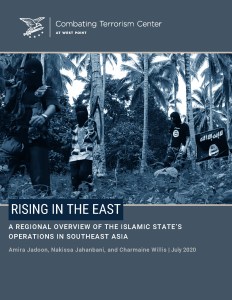
In 2016, the Islamic State acknowledged a series of pledges from Southeast Asian militant groups by declaring Isnilon Hapilon of the Abu Sayyaf Group to be the regional emir and encouraging local supporters to travel to the Philippines to wage jihad. Since 2016, a wave of Islamic State-linked attacks, including attempted and successful suicide attacks across the region, as well as the Marawi siege in 2017 by Islamic State-linked groups, has raised significant regional security concerns. Critical questions about the growing influence of the Islamic State in Southeast Asia, the interconnectedness of Islamic State affiliates, and the risks associated with returning fighters from Iraq and Syria remain unanswered.
In the first of a four-part series on the Islamic State in Southeast Asia, this report sheds light on the overarching characteristics of Islamic State-linked operations across Indonesia, Malaysia, and the Philippines between 2014 and 2019, highlighting how the Islamic State’s arrival has affected regional militancy. Drawing on open-source materials, the report maps the characteristics and regional dispersion of Islamic State-linked activity in the region, providing regional and country-level context for the nature of the threat. Additionally, the report identifies six regional militant groups as the Islamic State’s operational affiliates, defined as groups that have claimed attacks concurrently with the Islamic State.
The findings of the report draw attention to a marked increase in the use of Islamic State-linked suicide attacks and lethality in 2019, and significant numbers of failed and foiled attacks by Islamic State-affiliated or -inspired individuals in Indonesia and Malaysia. While the most important dimension of the Islamic State threat may be the existing militant infrastructure offered by its operational alliances in the Philippines and Indonesia, the threat in Malaysia exists in the form of independent plotters and radicalized individuals who present a pool of potential recruits for existing networks of militants in the region.
December 28, 2020: An updated version of this report replaced the original version. This update corrected a few minor typos and instances of unclear phrasing.
This report is the first in a series of four reports that map the Islamic State’s presence in Southeast Asia between 2015 and 2019. The second report, which provides an overview of the characteristics of Islamic State-linked operations in the Philippines between 2014 and 2019, is available here.
 Skip to content
Skip to content

